汽车专业英语 Braking System
- 格式:ppt
- 大小:413.50 KB
- 文档页数:20
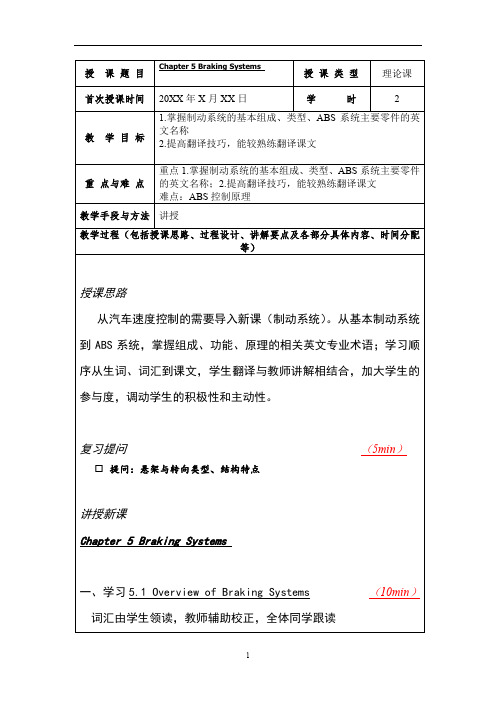
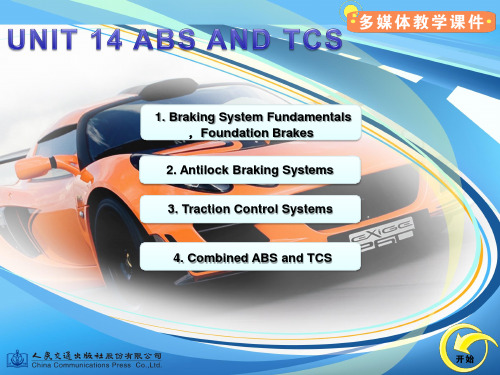
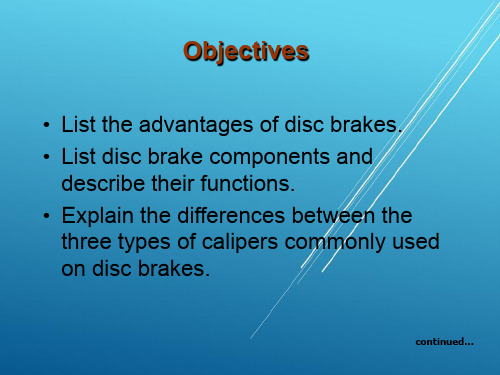
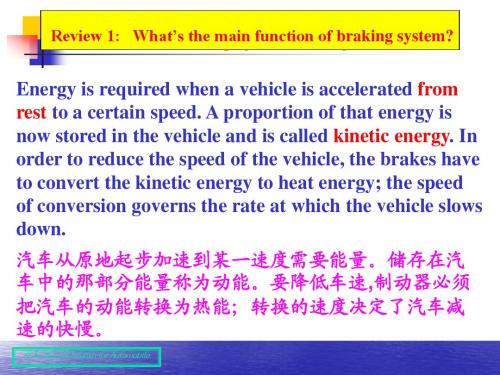

第一章汽车总论1)Today ’s average c ar contains more than 15,00 0 separate, individual parts that m u s twork t o g e t he r. These parts can be grouped into four major categories: body, engine, chassis and electrical equipment 。
P1现在的车辆一般都由15000 多个分散、独立且相互配合的零部件组成。
这些零部件主要分为四类:车身、发动机、底盘和电气设备。
2)The e ngine acts as the p ower unit. The i nternal combustionengine i s most c o m m o n:this obtains its power by burninga liquid fuel inside the engine cylinder. There are twotypes of engine: gasoline (also called a spark-ignition engine) and diesel (also called a compression-ignition engine). Both engines are called heat engines; the burning fuel ge ne rat es heat whichcauses the gas inside the cylinder to i ncrease its pressure andsu p p lypower to rotate a shaft connected to the power train. P3发动机作为动力设备,常见的类型是内燃机,其原理是通过发动机缸内的液体燃料燃烧而产生能量。
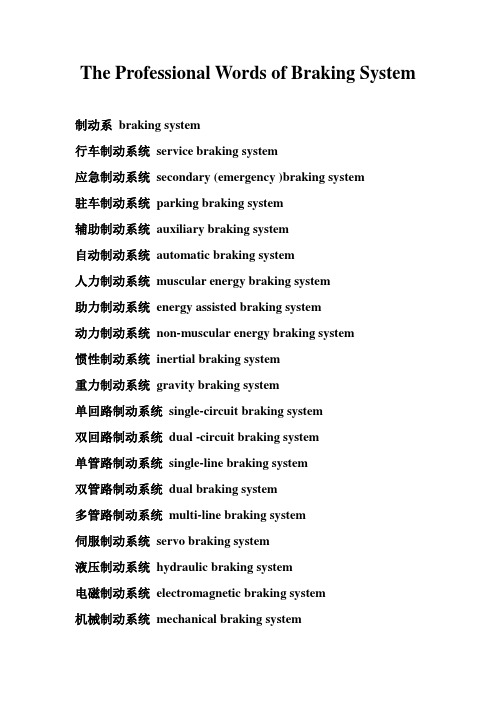
The Professional Words of Braking System制动系braking system行车制动系统service braking system应急制动系统secondary (emergency )braking system驻车制动系统parking braking system辅助制动系统auxiliary braking system自动制动系统automatic braking system人力制动系统muscular energy braking system助力制动系统energy assisted braking system动力制动系统non-muscular energy braking system惯性制动系统inertial braking system重力制动系统gravity braking system单回路制动系统single-circuit braking system双回路制动系统dual -circuit braking system单管路制动系统single-line braking system双管路制动系统dual braking system多管路制动系统multi-line braking system伺服制动系统servo braking system液压制动系统hydraulic braking system电磁制动系统electromagnetic braking system机械制动系统mechanical braking system渐进制动gradual braking制动能源braking energy source制动力矩braking torque总制动力total braking force总制动距离total braking distance有效制动距离active braking distance制动力分配率braking force distribution rate制动效能因素(制动强度)braking efficiency factor 制动力braking force瞬时制动功率instantaneous braking power停车距离(制动距离)stopping distance制动反应时间reaction time有效制动时间active braking time驾驶员反应时间reaction time of driver总制动时间total braking time单轮控制individual wheel control多轮控制multi-wheel control控制频率control frequency制动器效能因素application force制动器输出力矩brake output torque制动器额定力矩brake rating torque制动蹄效能因素brake shoe efficiency factor制动蹄作用压力application pressure of brake shoe assembly 制动蹄释放压力release pressure of brake shoe(鼓或盘)的摩擦面积swept area踏板行程pedal travel踏板自由行程free pedal travel踏板最大行程maximum pedal travel有效踏板长度effective pedal length制动初速度initial speed of braking制动减速度braking deceleration瞬时制动减速度instantaneous braking deceleration平均制动减速度mean braking deceleration最大制动减速度maximum braking deceleration冷却液cooling liquid供能装置energy supplying device真空泵vacuum pump空压机air compressor调压阀pressure regulating valve单向阀single check valve(one-way valve; retaining valve)止回阀、单向阀check valve控制装置control device行车制动踏板装置service braking pedal device制动踏板braking pedal衬套bushing回位弹簧return spring操纵杆control lever制动杆brake lever推杆plunger气阀air valve平衡弹簧equalizing spring快泄阀quick release valve制动主缸brake master cylinder弹簧座spring seat活塞挡圈piston stopper主缸储液室master cylinder reservoir 进油阀inlet valve轮缸wheel cylinder伺服机构servo mechanism助力器booster真空助力器vacuum booster伺服阀servo valve控制膜片control diaphragm液压阀hydraulic valve管路pipe-line制动管路braking line应急制动管路secondary line制动软管总成brake hose assemblies制动软管braking hose液压软管hydraulic hose密封圈sealing ring压力环pressure ring摩擦式制动器friction brake鼓式制动器drum brake盘式制动器disc brake多片盘式制动器multiple disc brake挂车制动器trailer brake超速制动器overrun brake液压制动器hydraulic brake双领蹄式制动器two leading shoe brake双从蹄式制动器two trailing shoe brake双向双领蹄式制动器dual two leading shoe brake 双向双从蹄式制动器dual two trailing shoe brake 领从蹄式制动器leading trailing shoe brake带式制动器band brake钳盘式制动器caliper disc brake定钳盘式制动器disc brake with fixed caliper浮钳盘式制动器disc brake with floating caliper浮盘式制动器floating disc brake凸轮制动器cam brake楔式制动器wedge brake驻车制动器parking brake手制动器hand brake制动鼓brake drum制动鼓衬里brake drum liner制动蹄brake shoe制动蹄总成brake shoe assembly领蹄(紧蹄)primary shoe(leading shoe) 从蹄(松蹄)secondary shoe(trailing shoe) 制动凸轮轴brake camshaft制动蹄回位弹簧brake shoe return spring 支承销anchor pin支承块anchor plate制动带brake band制动盘brake disc制动钳brake caliper制动衬片brake lining减速器、缓冲器retarder传感器sensor/transducer控制器controller调节器modulator限压阀pressure limiting valve比例阀proportioning valve惯性防抱死装置inertia anti-lock device电子防抱死装置electronic anti-lock device 报警装置warning device真空报警开关vacuum warning switch低压报警开关low pressure warning switch 附加装置additional device调压阀pressure regulating valve安全阀relief valve(safety valve)液压继动阀hydraulic relay valve手制动阀hand brake valve制动灯开关braking light switch鉴定试验qualification test试验设备(台)test rig制动拖滞braking drag制动颤振brake chatter制动噪声brake noise制动跑偏braking deviation制动失效braking failure制动滑移braking skid后轮防抱死制动系统rear wheel antilock system两轮防抱死制动系统two-wheel antilock braking system整体(组合)式防抱死系统integrated/integral antilock system 附加(分置)式防抱死制动系统add on antilock system;nonintegral/independent antilock system 3通道式防抱死系统3-channel antilock system对角线分路式防抱死制动系统diagonal split antilock system前/后轮分路式防抱死制动系统front/real split antilock system 车轮制动器wheel brake。
汽车专业英语常见缩略语释义EFI即英文Electronic Fuel Injection的缩写,意为“电子控制汽油直接喷射系统”。
该系统直接向进气管或气缸内喷射汽油,它通过各种不同的传感器采集发动机转速、节气门开度、冷却水温、空气流量及温度等信号输入电子控制元件,以控制汽油和空气的供给量,从而配制成适于发动机工况的最佳可燃混合气。
ABS即英文Anti-lock Braking System的缩写,意为“防抱死制动系统”。
它是利用传感器检测车轮的旋转速度,由计算机(ECU)控制执行元件防止车轮抱死的汽车安全装置。
4WS英文Four Wheel Steer的缩写,意为“四轮转向系统”。
该装置装有后轮悬架控制后轮的转向机构,并采用与前轮转向机构进行机械连动的电子控制,以决定后轮的转向及转向角。
如果附加横向摆动率反馈控制,能主动适应行驶中横向摆动率变化,以确保车辆行驶的稳定性。
4WD即英文Four Wheel drive的缩写,意为“四轮驱动系统”。
汽车通过分动器将发动机的转矩分配给前后轮,使前后轮同时驱动汽车前进,提高了行驶的稳定性和越野性。
ECS即英文Electronic Controlled Suspension的缩写,意为“电子控制悬架”。
它可根据路面情况,调节悬架弹性元件的刚度和减振器的阻力,使振动和冲击迅速消除。
此外,智能悬架还可以自动调节车身的离地高度,即使汽车在崎岖的路面上行驶也可顺利通过路面障碍,使乘客感觉平稳和舒适。
SRS即英文Supplemental Restraint System的缩写,意为“汽车安全气囊”。
它的主要作用是当汽车遭受冲撞时,气囊迅速膨胀,承受并缓冲驾驶员或乘员头部与身体上部产生的惯性力,从而减轻人体受到的伤害程度。
它是辅助座椅安全带起防护作用的一种被动安全装置。
ITS ITS即英文Intelligent Transport System的缩写,意为“智能运输系统”。
Automobile Brake SystemThe braking system is the most important system in cars. If the brakes fail, the result can be disastrous. Brakes are actually energy conversion devices, which convert the kinetic energy (momentum) of the vehicle into thermal energy (heat).When stepping on the brakes, the driver commands a stopping force ten times as powerful as the force that puts the car in motion. The braking system can exert thousands of pounds of pressure on each of the four brakes.Two complete independent braking systems are used on the car. They are the service brake and the parking brake.The service brake acts to slow, stop, or hold the vehicle during normal driving. They are foot-operated by the driver depressing and releasing the brake pedal. Theprimary purpose of the brake is to hold the vehicle stationary while it is unattended. The parking brake is mechanically operated by when a separate parking brake foot pedal or hand lever is set.The brake system is composed of the following basic components: the “master cylinder” which is located under the hood, and is directly connected to the brake pedal, converts driver foot’s mechanical pressure into hydraulic pressure. Steel “brake lines” and flexible “brake hoses” connect the master cylinder to the “slave cylinders” located at each wheel. Brake fluid, specially designed to work in extreme conditions, fills the system. “Shoes” and “pads” are pushed by the slave cylinders to contact the “drums” and “rotors” thus causing drag, which (hopefully) slows the car.The typical brake system consists of disk brakes in front and either disk or drumbrakes in the rear connected by a system of tubes and hoses that link the brake at each wheel to the master cylinder (Figure).Basically, all car brakes are friction brakes. When the driver applies the brake, the control device forces brake shoes, or pads, against the rotating brake drum or disks at wheel. Friction between the shoes or pads and the drums or disks then slows or stops the wheel so that the car is braked.In most modern brake systems (see Figure 15.1), there is a fluid-filled cylinder, called master cylinder, which contains two separate sections, there is a piston in each section and both pistons are connected to a brake pedal in the driver’s compartment. When the brake is pushed down, brake fluid is sent from the master cylinder to the wheels. At the wheels, the fluid pushes shoes, or pads, against revolving drums or disks. The friction between the stationary shoes, or pads, and the revolving drums or disks slows and stops them. This slows or stops the revolving wheels, which, in turn, slow or stop the car.The brake fluid reservoir is on top of the master cylinder. Most cars today have a transparent r reservoir so that you can see the level without opening the cover. The brake fluid level will drop slightly as the brake pads wear. This is a normal condition and no cause for concern. If the level drops noticeably over a short period of time or goes down to about two thirds full, have your brakes checked as soon as possible. Keep the reservoir covered except for the amount of time you need to fill it and never leave a cam of brake fluid uncovered. Brake fluid must maintain a very high boiling point. Exposure to air will cause the fluid to absorb moisture which will lower that boiling point.The brake fluid travels from the master cylinder to the wheels through a series of steel tubes and reinforced rubber hoses. Rubber hoses are only used in places that require flexibility, such as at the front wheels, which move up and down as well as steer. The rest of the system uses non-corrosive seamless steel tubing with special fittings at all attachment points. If a steel line requires a repair, the best procedure is to replace the compete line. If this is not practical, a line can be repaired using special splice fittings that are made for brake system repair. You must never use copper tubing to repair a brake system. They are dangerous and illegal.Drum brakes, it consists of the brake drum, an expander, pull back springs, a stationary back plate, two shoes with friction linings, and anchor pins. The stationaryback plate is secured to the flange of the axle housing or to the steering knuckle. The brake drum is mounted on the wheel hub. There is a clearance between the inner surface of the drum and the shoe lining. To apply brakes, the driver pushes pedal, the expander expands the shoes and presses them to the drum. Friction between the brake drum and the friction linings brakes the wheels and the vehicle stops. To release brakes, the driver release the pedal, the pull back spring retracts the shoes thus permitting free rotation of the wheels.Disk brakes, it has a metal disk instead of a drum. A flat shoe, or disk-brake pad, is located on each side of the disk. The shoes squeeze the rotating disk to stop the car. Fluid from the master cylinder forces the pistons to move in, toward the disk. This action pushes the friction pads tightly against the disk. The friction between the shoes and disk slows and stops it. This provides the braking action. Pistons are made of either plastic or metal. There are three general types of disk brakes. They are the floating-caliper type, the fixed-caliper type, and the sliding-caliper type. Floating-caliper and sliding-caliper disk brakes use a single piston. Fixed-caliper disk brakes have either two or four pistons.The brake system assemblies are actuated by mechanical, hydraulic or pneumatic devices. The mechanical leverage is used in the parking brakes fitted in all automobile. When the brake pedal is depressed, the rod pushes the piston of brake master cylinder which presses the fluid. The fluid flows through the pipelines to the power brake unit and then to the wheel cylinder. The fluid pressure expands the cylinder pistons thus pressing the shoes to the drum or disk. If the pedal is released, the piston returns to the initial position, the pull back springs retract the shoes, the fluid is forced back to the master cylinder and braking ceases.The primary purpose of the parking brake is to hold the vehicle stationary while it is unattended. The parking brake is mechanically operated by the driver when a separate parking braking hand lever is set. The hand brake is normally used when the car has already stopped. A lever is pulled and the rear brakes are approached and locked in the “on” position. The car may now be left without fear of its rolling away. When the driver wants to move the car again, he must press a button before the lever can be released. The hand brake must also be able to stop the car in the event of the foot brake failing. For this reason, it is separate from the foot brake uses cable or rods instead of the hydraulic system.Anti-lock Brake SystemAnti-lock brake systems make braking safer and more convenient, Anti-lock brake systems modulate brake system hydraulic pressure to prevent the brakes from locking and the tires from skidding on slippery pavement or during a panic stop.Anti-lock brake systems have been used on aircraft for years, and some domestic car were offered with an early form of anti-lock braking in late 1990’s. Recently, several automakers have introduced more sophisticated anti-lock system. Investigations in Europe, where anti-lock braking systems have been available for a decade, have led one manufacture to state that the number of traffic accidents could be reduced by seven and a half percent if all cars had anti-lock brakes. So some sources predict that all cars will offer anti-lock brakes to improve the safety of the car.Anti-lock systems modulate brake application force several times per second to hold the tires at a controlled amount of slip; all systems accomplish this in basically the same way. One or more speed sensors generate alternating current signal whose frequency increases with the wheel rotational speed. An electronic control unit continuously monitors these signals and if the frequency of a signal drops too rapidly indicating that a wheel is about to lock, the control unit instructs a modulating device to reduce hydraulic pressure to the brake at the affected wheel. When sensor signals indicate the wheel is again rotating normally, the control unit allows increased hydraulic pressure to the brake. This release-apply cycle occurs several time per second to “pump” the brakes like a driver might but at a much faster rate.In addition to their basic operation, anti-lock systems have two other things in common. First, they do not operate until the brakes are applied with enough force to lock or nearly lock a wheel. At all other times, the system stands ready to function but does not interfere with normal braking. Second, if the anti-lock system fail in any way, the brakes continue to operate without anti-lock capability. A warning light on the instrument panel alerts the driver when a problem exists in the anti-lock system.The current Bosch component Anti-lock Braking System (ABSⅡ), is a second generation design wildly used by European automakers such as BWM, Mercedes-Benz and Porsche. ABSⅡsystem consists of : four wheel speed sensor, electronic control unit and modulator assembly.A speed sensor is fitted at each wheel sends signals about wheel rotation tocontrol unit. Each speed sensor consists of a sensor unit and a gear wheel. The front sensor mounts to the steering knuckle and its gear wheel is pressed onto the stub axle that rotates with the wheel. The rear sensor mounts the rear suspension member and its gear wheel is pressed onto the axle. The sensor itself is a winding with a magnetic core. The core creates a magnetic field around the winding, and as the teeth of the gear wheel move through this field, an alternating current is induced in the winding. The control unit monitors the rate o change in this frequency to determine impending brake lockup.The control unit’s function can be divided into three parts: signal processing, logic and safety circuitry. The signal processing section is the converter that receives the alternating current signals form the speed sensors and converts them into digital form for the logic section. The logic section then analyzes the digitized signals to calculate any brake pressure changes needed. If impending lockup is sensed, the logic section sends commands to the modulator assembly.Modulator assemblyThe hydraulic modulator assembly regulates pressure to the wheel brakes when it receives commands from the control utuit. The modulator assembly can maintain or reduce pressure over the level it receives from the master cylinder, it also can never apply the brakes by itself. The modulator assembly consists of three high-speed electric solenoid valves, two fluid reservoirs and a turn delivery pump equipped with inlet and outlet check valves. The modulator electrical connector and controlling relays are concealed under a plastic cover of the assembly.Each front wheel is served by electric solenoid valve modulated independently by the control unit. The rear brakes are served by a single solenoid valve and modulated together using the select-low principle. During anti-braking system operation, the control unit cycles the solenoid valves to either hold or release pressure the brake lines. When pressure is released from the brake lines during anti-braking operation, it is routed to a fluid reservoir. There is one reservoir for the front brake circuit. The reservoirs are low-pressure accumulators that store fluid under slight spring pressure until the return delivery pump can return the fluid through the brake lines to the master cylinder.汽车制动系统制动系统是汽车中最重要的系统。
ABS:ABS (Anti-lock Braking System)防抱死制动系统,通过安装在车轮上的传感器发出车轮将被抱死的信号,控制器指令调节器降低该车轮制动缸的油压,减小制动力矩,经一定时间后,再恢复原有的油压,不断的这样循环(每秒可达5~10次),始终使车轮处于转动状态而又有最大的制动力矩。
没有安装ABS的汽车,在行驶中如果用力踩下制动踏板,车轮转速会急速降低,当制动力超过车轮与地面的摩擦力时,车轮就会被抱死,完全抱死的车轮会使轮胎与地面的摩擦力下降,如果前轮被抱死,驾驶员就无法控制车辆的行驶方向,如果后轮被抱死,就极容易出现侧滑现象。
ABS这种最初被应用于飞机上的技术,现在已经十分普及,在十万元以上级别的轿车上都可见到它的踪影,有些大客车上也装有ABS。
装有ABS的车辆在遇到积雪、冰冻或雨天等打滑路面时,可放心的操纵方向盘,进行制动。
它不仅有效的防止了事故的发生,还能减少对轮胎的摩损,但它并不能使汽车缩短制动距离,在某些情况下反而会有所增加。
提示:在遇到紧急情况时,制动踏板一定要踩到底,才能激活ABS系统,这时制动踏板会有一些抖动,有时还会有一些声音,但也不能松开,这表明ABS系统开始起作用了。
EBD:EBD的英文全称是Electronic Brake forceDistribution,即电子制动力分配装置。
汽车在制动时,因为四只轮胎所附着的地面条件不同,其与地面的摩擦力也不同,制动时就容易产生打滑、倾斜和侧翻等现象,为了有效的避免这种现象,电子制动力分配装置就应运而生,它的作用就是在汽车制动的瞬间,通过对四只轮胎附着的不同地面情况进行感应、计算,得出不同的磨擦力数值,使四只轮胎的制动装置根据不同的情况用不同的方式和力量制动,并在运动中不断高速调整,从而保证车辆的平稳、安全。
有人认为EBD比ABS先进,其实不然,它是ABS系统的有效补充,一般和ABS组合使用,可以提高ABS的功效。
当发生紧急制动时,EBD在ABS作用之前,可依据车身的重量和路面条件,自动以前轮为基准去比较后轮轮胎的滑动率,如发觉此差异程度必须被调整时,刹车油压系统将会调整传至后轮的油压,以得到更平衡且更接近理想化的刹车力分布。